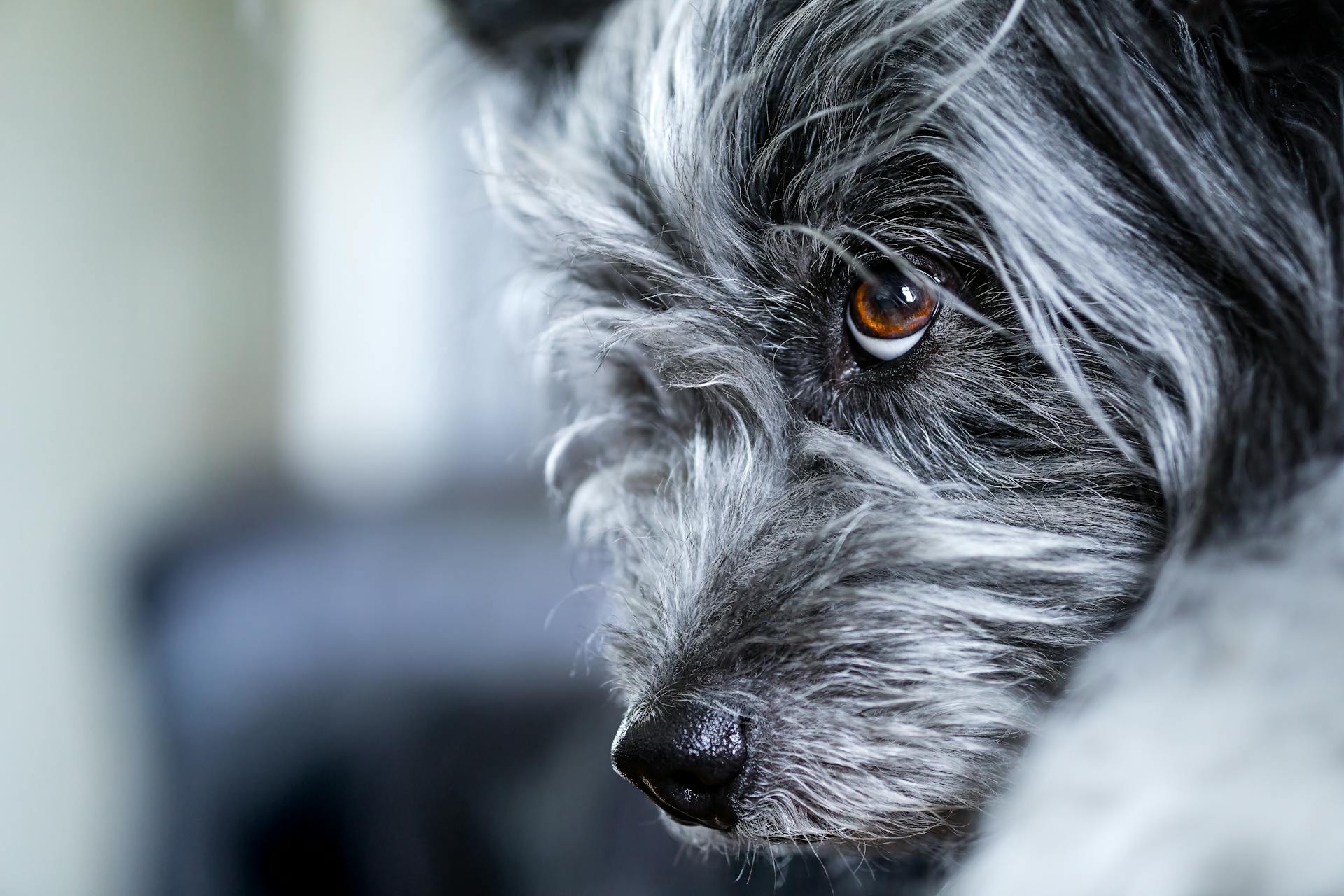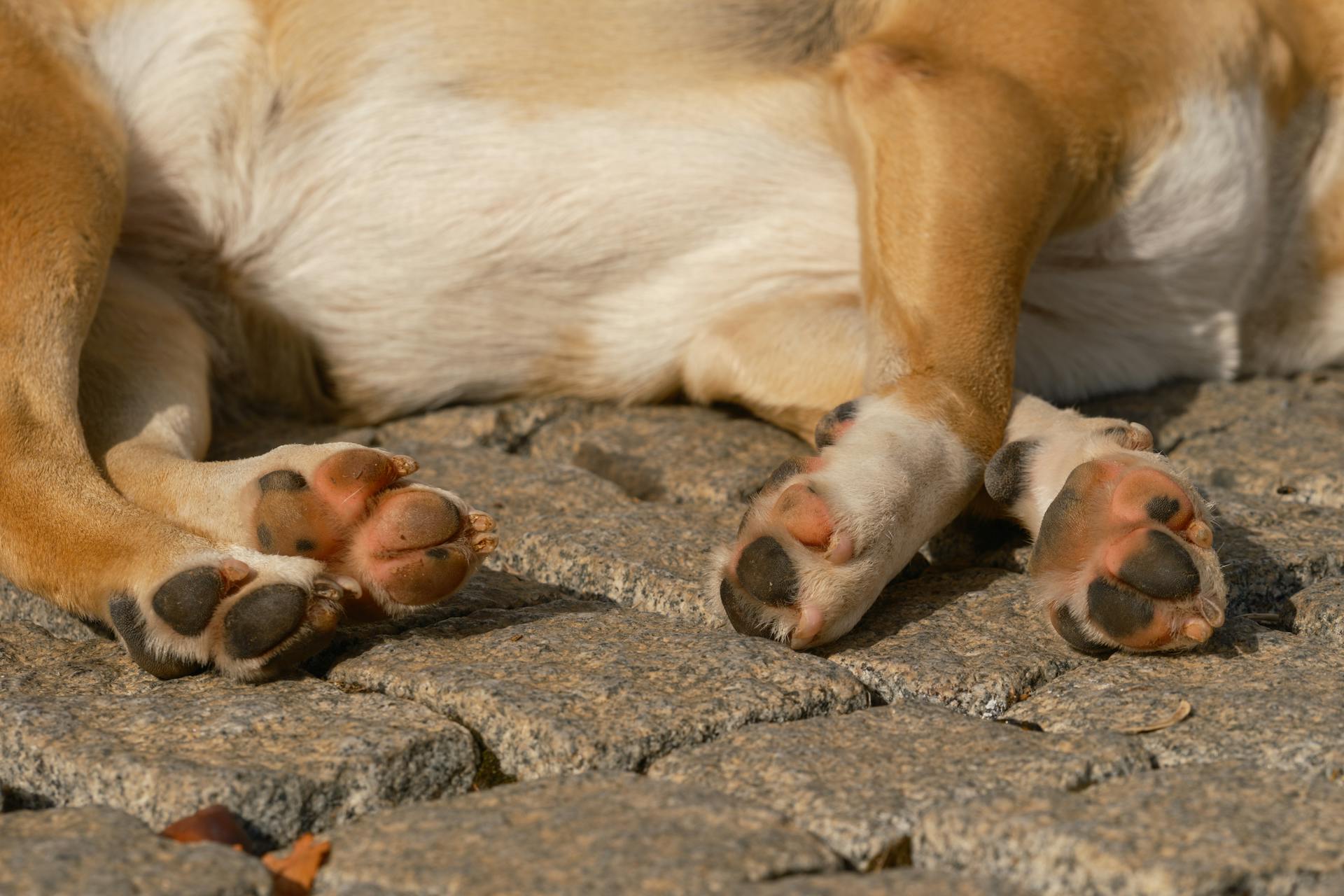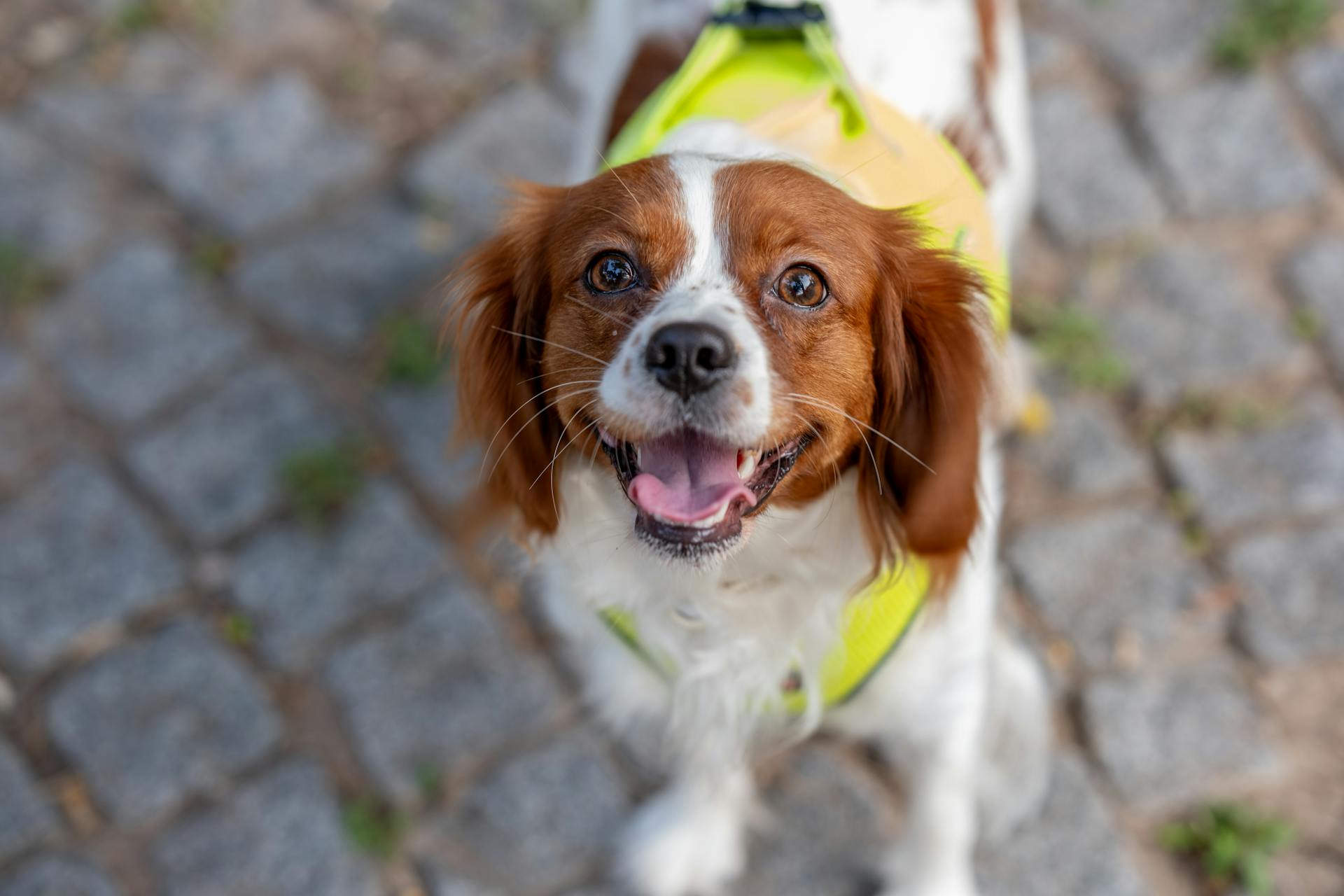
The maxillary canine, also known as the upper canine, is a vital tooth in the dental arch. It plays a crucial role in biting and tearing food.
The maxillary canine is characterized by its pointed shape and single root. In most cases, it has a single root, but in some instances, it can have two roots.
The maxillary canine is located between the maxillary lateral incisor and the maxillary first premolar. This tooth is essential for maintaining proper alignment and function in the dental arch.
Its unique shape allows it to efficiently pierce and tear food, making it an essential component of the masticatory system.
For more insights, see: Canine Dental Anatomy
Canine Anatomy
A maxillary canine has a unique composition of four developmental lobes, three facial and one lingual, which gives it a distinct shape.
The lingual lobe of a canine is much larger and thicker than the lingual lobe of an incisor, resulting in the canine being wider labiolingually.
The cingulum of a maxillary canine is larger and bulkier than the cingulum on any other anterior tooth, contributing to its overall shape.
The root of a canine is broad labiolingually and is usually extremely long, with the end of the root apex often curving to the lingual or distal lingual side.
The mesial surface of the root shows much labiolingual development, with a shallow developmental depression extending from the cervical line halfway to the apex of the root.
Mandibular Permanent Canines
The mandibular permanent canines are the longest teeth in the mouth.
Located at the corners of the mouth, they are well anchored in the bone by their extremely long roots.
Their location requires extra anchorage, which is furnished by the length and the shape of their roots and a special projection of bone called the canine eminence.
In function, the canines act as holding and tearing tools and assist both the incisors and premolars.
Their V shape at the corner of the mouth allows for dissipation of pressures that can force the premolars to protrude out of the mouth or the incisors farther into the mouth.
The self-cleaning qualities of the canines, their smooth, pointed shape, the thickness of their crowns, and their strong anchorage make the canines the most stable teeth in the mouth.
Evidence of calcification of mandibular permanent canines starts at 4 months.
Permanent Mandibular Canine
The permanent mandibular canine is a key tooth in the lower jaw. It has a single pointed cusp, which plays an intermediate role between incising and grinding.
Its root tapers gradually to a pointed apex, similar to the maxillary canine. This unique shape allows for efficient food processing and biting forces.
The mandibular canine is positioned within the dental arch, playing a crucial role in the overall alignment of the teeth. Its prominent lingual ridge is a distinctive feature that sets it apart from other teeth.
Labial Aspect (Fig. 13-2)
The labial aspect of a maxillary canine is quite distinctive. The crown and root are narrower mesiodistally than those of a maxillary central incisor.
The crown of a maxillary canine has a much larger cervicoincisal length than most other anterior teeth. This makes it one of the longest teeth in the mouth.
The outline of the crown is straighter mesially than laterally, with a slight convexity at the contact area. The center of the mesial contact area is approximately at the junction of the middle and incisal thirds of the crown.
The distal contact area is usually located at the center of the middle third of the crown, making the distal convexity appear larger and more uniform. This is in contrast to the mesial contact area.
The labial surface of the crown is smooth, with two shallow depressions dividing the three labial lobes. The middle lobe is much larger and has greater development than the other lobes.
The cervical line crests slightly mesial to the center of the tooth.
Lingual Aspect
The lingual aspect of a maxillary canine is quite unique and interesting. The root of a maxillary canine tapers toward the lingual surface.
The lingual sides of both the crown and root are narrower than the labial sides. This is a distinct characteristic that sets canines apart from other anterior teeth.
The cervical line on the lingual aspect shows a more even curvature, and the crest is straighter and centered over the middle of the tooth. This is a notable feature that can be observed in a maxillary canine.
The most obvious structure on the lingual surface of a maxillary canine is the well-developed cingulum. It's huge in comparison with those of all the other anterior teeth.
The cingulum is often confluent with a well-developed lingual ridge that runs from the cusp tip to the cingulum. This ridge is a key feature of the lingual aspect of a maxillary canine.
Sometimes the lingual surface of a canine crown is so smooth that no concavities or fossae are present. In these cases, the cingulum and marginal ridges are less developed, with little evidence of developmental grooves.
A cross-sectional view of the root appears triangular, with the lingual portion more tapered than the labial. This is a characteristic that can be observed in a maxillary canine.
Mesial Aspect
The mesial aspect of a maxillary canine is a crucial part of its overall anatomy. The wedge-shaped outline of the crown shows the canine to have greater labiolingual bulk than any other anterior tooth.
The greatest measurement labiolingually is at the cervical third, which is due to the huge cingulum of the lingual side and the more convex labial outline of the canine. This is a key characteristic that sets canines apart from other maxillary anterior teeth.
The entire labial surface is more convex from the cervical line to the cusp tip than any other maxillary anterior tooth. This is important to keep in mind when evaluating the shape and structure of a canine.
The cervical line curves toward the cusp an average of 2.5 mm, which is a notable feature of the mesial aspect. This curvature is a result of the canine's unique anatomy.
The root of a canine is broad labiolingually and is usually extremely long, with the end of the root apex being blunt and sometimes curving to the lingual or distal lingual side. This is a common observation when examining canine roots.
The mesial surface of the root shows much labiolingual development, with a shallow developmental depression extending from the cervical line halfway to the apex of the root. This depression helps anchor the canine in the bone and prevents root rotation.
Discussion
Maxillary canines are typically considered to be single-rooted, single-canal teeth.
Vertucci classified the root canal configurations of human permanent teeth into various types, ranging from single to three separate and distinct canals.
Pineda et al and Hulsmann reported cases of single-rooted maxillary canines with two root canals.
Grossman et al and Nelson and Ash also reported two-rooted maxillary canines.
Bolla and Kavuri, as well as Mohammed et al, reported double roots of maxillary anterior teeth with two root canals.
This patient had a rare condition of three separated roots with three separate root canals, identified as mesiobuccal, distobuccal, and palatal roots.
Frequently Asked Questions
How can you tell if this is a maxillary canine?
To identify a maxillary canine, look for a central strengthening ridge on the lingual surface extending from the cingulum to the cusp. This distinctive feature is not typically found on mandibular canines.
At what age do maxillary canines erupt?
Maxillary canines typically erupt between the ages of 10-12 years, but this can vary by several years.
Featured Images: pexels.com


